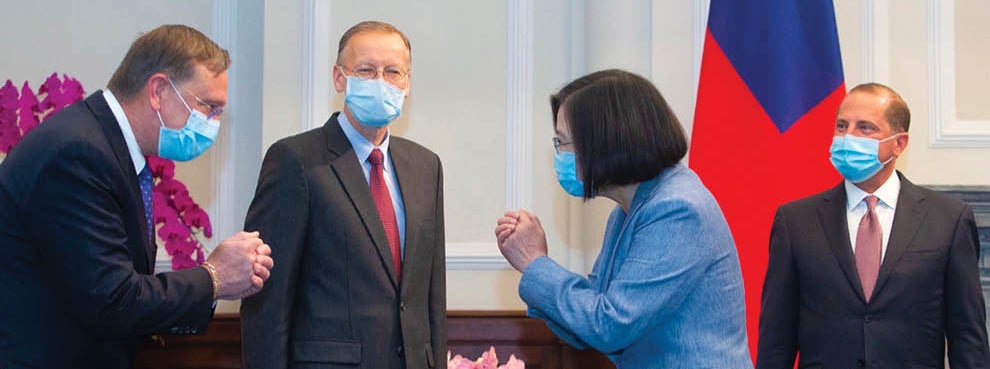Has the bilateral environment ever been stronger for a free-trade agreement (FTA) between Taiwan and the U.S.? At least half of the U.S. Senate believes the time is right, sending a joint letter to U.S. Trade Representative Bob Lighthizer asking him to start negotiations.
“We are confident that a U.S.-Taiwan trade agreement would promote security and economic growth for the United States, Taiwan and the Indo-Pacific as a whole,” the letter argues.
There is greater FTA receptivity on both sides, in part because of a growing concern about China and also due to a growing recognition in Taiwan that its economy might be at risk if it does not improve its international connectivity.
A friend from the Taiwan government explained that the island might potentially lose competitiveness by being left out of trade agreements. Taiwan is not part of ASEAN, and its participation in regional or bilateral trade agreements can be easily blocked by China. Taiwan corporations need an international gateway for trade.
Currently about half of Taiwan’s trade is with China or Hong Kong, as is up to 80% of its investment, an over-concentration of economic activity. The U.S. can provide an alternative path.
And from a U.S. perspective, an FTA with Taiwan would bring modest economic benefits as well. The IMF ranked Taiwan’s economy the 20th largest in the world. Its GDP of just under $600 billion places it between Switzerland and Poland. But that understates its trade role: Taiwan is America’s 10th largest trading partner, ahead of either India or France.
Yet there are no talks underway or planned. For one, the U.S. is ambivalent about trade liberalization, with USTR chief Lighthizer explicitly critical of FTAs. For its part, Taiwan also has domestic constituencies that are sensitive to additional competition.
Most important, the shadow of Beijing falls over the talks. It would be a mistake for the U.S. to pursue an FTA as part of its China policy or to use Taiwan as a bargaining chip, and Taiwan has reasons to be wary as well. A friendly improvement in trade is usually a good idea, but not if it is being done to bait a third party. Taking a step toward better economic ties with Taiwan should not be perceived as degrading relations with China.
So how to construct the right kind of FTA?
First, it must be a full-spectrum agreement, including manufacturing, services, and agriculture. You don’t get to fix or improve an FTA after it is signed, so it is worth spending the time necessary to make it world class. The most sensitive sector is likely to be agriculture, as Taiwan has a significant body of small-scale farmers. The island’s government will need to find mechanisms to support those who have trouble competing. Instruments like a government land-bank and a reverse mortgage could do the trick, allowing a farmer to sell his land to the government in exchange for a lifetime ability to maintain the property as his residence along with 20 years of guaranteed income.
Second, the FTA would also need to be digital. Let’s let every consumer and business in Taiwan benefit from the strengths of the U.S. tech sector.
Third, the U.S. should think about incorporating a Taiwan FTA in a border trade initiative. The U.S. could solicit interest in FTAs and allow other economies to respond. The point here is that the U.S. is interested in improving trade with all economies (Lighthizer notwithstanding) and any Taiwan initiative should be viewed in that context. In fact, why not launch the FTA talks and TPP talks simultaneously?
Fourth, Taiwan could continue to tidy up with selective liberalization. One example: Are there economic sectors where Taiwan currently has higher tariffs or trade barriers than China? Regardless of the immediate likelihood of an FTA, it would not appear to be in Taiwan’s interest to be less open to the U.S. than China.
Lastly, the FTA should model and communicate. Time to start exploring what an FTA would look like., and let’s not limit the discussion to bilateral trade. What would be the anti-inflationary impact? Would Taiwan investors have greater access to U.S. financial instruments? What would be the benefit to the Taiwan-China supply chain? Which U.S. cities might develop air links to Taiwan? It would be useful to start the rounds of think-tank work, panel discussions and modeling. If the desire is for the U.S.-Taiwan FTA to become real some day, let’s start discussing what “real” means.
Thanks to the U.S. Senate for helping move the conversation along. Let’s hope the U.S. and Taiwan can run with the ball.
Frank Lavin is the CEO and founder of Export Now, former under secretary for International Trade at the U.S. Department of Commerce, former US Ambassador to Singapore.
To read the original blog post, click here.

